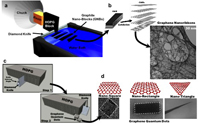May 16, 2012
Professor uses diamond to produce graphene quantum dots and nano-ribbons of controlled structure
Submitted by Division of Communications and Marketing

Kansas State University researchers have come closer to solving an old challenge of producing graphene quantum dots of controlled shape and size at large densities, which could revolutionize electronics and optoelectronics.
Vikas Berry, William H. Honstead professor of chemical engineering, has developed a novel process that uses a diamond knife to cleave graphite into graphite nanoblocks, which are precursors for graphene quantum dots. These nanoblocks are then exfoliated to produce ultrasmall sheets of carbon atoms of controlled shape and size.
By controlling the size and shape, the researchers can control graphene’s properties over a wide range for varied applications, such as solar cells, electronics, optical dyes, biomarkers, composites and particulate systems. Their work has been published in Nature Communications and supports the university's vision to become a top 50 public research university by 2025. The article is available online.
"The process produces large quantities of graphene quantum dots of controlled shape and size and we have conducted studies on their structural and electrical properties," Berry said.
While other researchers have been able to make quantum dots, Berry's research team can make quantum dots with a controlled structure in large quantities, which may allow these optically active quantum dots to be used in solar cell and other optoelectronic applications.
"There will be a wide range of applications of these quantum dots," Berry said. "We expect that the field of graphene quantum dots will evolve as a result of this work since this new material has a great potential in several nanotechnologies."
It has been know that because of the edge states and quantum confinement, the shape and size of graphene quantum dots dictate their electrical, optical, magnetic and chemical properties. This work also shows proof of the opening of a band-gap in graphene nanoribbon films with a reduction in width. Further, Berry’s team shows through high-resolution transmission electron micrographs and simulations that the edges of the produces structures are straight and relatively smooth.
Other collaborators on this work include Zhiping Xu from Tsinghua University in China and David Moore from the University of Kansas. Xu conducted the molecular dynamics simulations. The co-authors from Kansas State University include Nihar Mohanty, 2011 doctoral graduate; T. S. Sreeprasad, postdoctoral fellow; Alfredo A. Rodriguez, 2012 graduate; and Ashvin Nagaraja, 2009 graduate.
The project was funded by the National Science Foundation and the office of naval research.
Berry earned his bachelor's degree in chemical engineering from the Indian Institute of Technology in Delhi, India, in 1999. He received his master's degree in chemical and petroleum engineering from the University of Kansas in 2003, followed by his doctorate in chemical engineering from Virginia Polytechnic Institute and State University in 2006.
